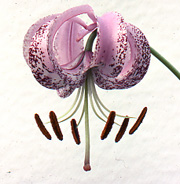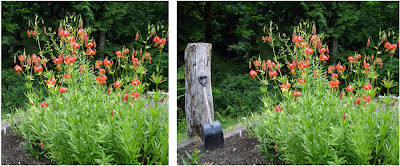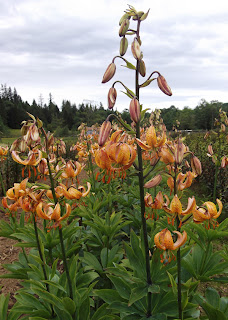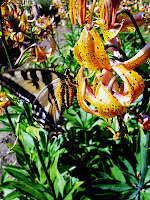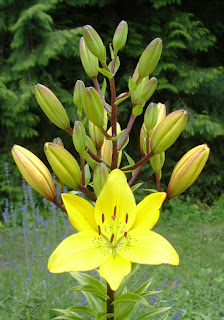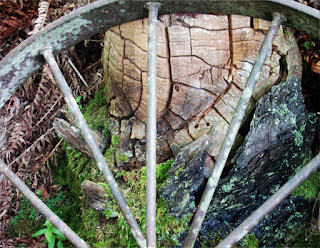 |
| Lemon-Poppy Seed muffins are good to eat! |
Poppy seeds are very small in size and add a quite delicious "crunch" to breads, cake and muffins, but did you know these beautiful flowers are easily grown in either full sun or bright shade? Regular garden soils, not too rich with compost and other amendments is perfect. Fast draining soils are a must however, and in gardens that are mostly clay - a raised bed with native soil, sand and a light proportion of compost - will work just fine to provide enough drainage from heavy rainfall or accidental over watering.
Annual Poppy seeds
(flowers in one season) can be planted anytime between fall and spring and you can collect the mature seeds to plant in another garden site for next year, use them in cooking or simply let the pods mature and fall in place - called "self sowing".
Poppies need light to germinate, so if you cover these tiny seeds with soil, peat, vermiculite, or sifted compost they will not grow. Fallen leaves from trees and shrubs can interfere with germination (cutting off the light), but snow is not a problem - as it melts, your poppies will begin to germinate whether they were fall planted by you or growing from mature pods dropped on the ground in fall.
 |
| 'Lankon' lilies with poppies growing in the row. |
However, seed that has been buried and then
brought to the surface during garden cleanup, roto-tilling or planting of other flowers may even germinate several years later.
In spring of 2010, Dianna scattered surplus seeds of her 'Purple Poppies' in a bare section of field.
Husband, Bob, not knowing what she had done, only saw Groundsel, Thistles and other weeds starting to grow in the "unused ground". He tilled the soil, effectively cutting the seed off from light and so none germinated, especially with subsequent cultivation and planting of oats to build up the soil in preparation for a future lily crop.
When oats are used for a cover crop, they are thickly sown and tilled into the ground when they've grown about a foot tall in order to add nutrients and of bio-mass to the soil - vastly improving the soil texture. Any poppy seed brought to the surface by the roto-tilling would not have had enough light to grow with the quick-to-sprout oats, or wouldn't had time to grow more than a few inches before those oats were dug into the soil. That fall a second round of oats were planted, tilled into the soil in late winter, and the lilies planted in March.
(See our blog post Semi-automated Planting of Lily Bulbs - where you can see an example of lush green oats growing in between lily rows.)
To everyone's surprise, after we finally left the soil alone for several weeks, a nice scattering of poppies began growing in between the lily sprouts - and were left to grow together over summer. After all, who could weed them out with all they had been through?
"Plant poppy seed in a specially prepared bed".
 |
| Dianna's Purple Poppies - flowers are 3 to 5 inches in size. |
1. Plant poppy seed in a specially prepared bed, cleaning out perennial weeds from an area about 18 inches across for one or two packets of seed. Deeply dig to loosen the soil and fluff it to lighten and find any missed roots. Do not use commercial potting soil, the texture is much too coarse for successful poppy germination by itself.
(More about that later.)
2. Water the planting site and let it sit overnight to firm the soil and provide ground moisture if the weather has been quite dry. This step is not necessary in fall through winter months, especially if the weather has been wet.
3. Using a small leaf rake, your fingers, a household fork or hand-held cultivator tool, scratch the surface to make a very shallow "texture" - not too deep - you only want the top 1/4 inch loosened without depressions for the seed to become lost.
4. Scatter seed evenly across the entire surface. You can mix the seed with fine sand and sprinkle from a pepper shaker or whatever method you like.
5. Gently pat down the planting area with your hands to firm the soil and ensure the seeds make contact and do not dry out.
(This is the reason why simply scattering seed throughout your garden does not work. Seeds will cling to leaves, sit on top of a rock or accidentally be buried while you weed.)
6. Water with a fine mist from your hose, so as to not form "puddles". During dry spring weather, keep the soil lightly moist until germination, after which you can let nature water the plants.
 |
| Mature poppy seed roots 12" long |
Transplanting small seedlings can be done carefully.
This is only possible if the newly germinated seedlings are less than 1/4 inch tall - much bigger and you risk disturbing the newly formed taproot and the developing feeder roots.
(The photograph on the left is of a 4 foot tall plant at the end of the season, that was pulled out of dry sandy soil, with nearly all the roots intact. See how there are not a lot of roots radiating out from the taproot, the reason you cannot move mature stems without damage.)
To transplant, you simply lift out sections of soil with a trowel about 2 to 3 inches across - do not try to separate the seedlings - and simply move the entire mini clump of 10 - 15 seedlings to a new section of prepared fluffy soil. The strongest seedlings in each clump will continue to grow.
Sowing poppy seeds in containers.
Commercial potting soil is generally more heavily textured than your native garden soil. When poppy seeds are sown on the surface, they will generally fall between the soil componets and not be accessible to light. When watered they may become buried even further. A solution would be to simply sow a 1/4 inch layer of very fine freshwater beach sand (not from salt water) on the surface of the potting soil and then scatter the seed on top of that. Poppy seeds do a fine job of self sowing on the finely crushed rock of our paths, so you can skip the "patting down" (step #5) but be certain to keep the pot slightly moist. The soil underneath the sand should stay moist, even if the sand on top appears drier. If you wish to grow the seed in 4" pots to transplant later, simply sow a few seeds in each container and transplant the entire root ball when the plants roots have begun to fill out the pot. Do not thin the plants, let the dominant seedlings grow. Do not try to separate the seedlings either - we tried that - and both halves died, probably because the fragile tap roots were damaged.
 |
| Ripening seed pods in the garden. |
Gathering seed in fall.
The brown colored pods in the photo are ready for harvest. We simply
cut them close to the pod as the color changes and leave everything in a
clean bucket to finish drying. We then pour the seed pods into a
household strainer and the tiny seeds fall through into a new bucket.
It is hard to retrieve all the seed in one or two passes, so the mostly
empty pods are then scattered over a cleaned and prepared garden to break down over winter
and release the remaining seed. Of course, you still need to be careful to not
accidentally pull out the tiny plants during spring cleaning or bury the not yet germinated seed with mulch.
'Dianna's Purple Poppy' seeds are available from B&D Lilies. Here is the link to order seed.






































